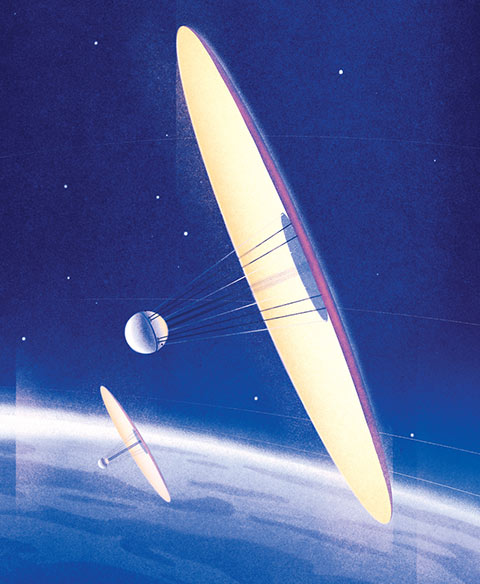Humans have long dreamed of going to the stars – but exactly how we’d get there has always been an open question. Once you’ve achieved a high speed, you can just coast along (thank you, Newton’s first law of motion) – but to get your speed up in the first place, you need some sort of propulsion system.
Today, we use chemical-burning rockets – but the fuel is heavy, which means launching a fuel-laden craft and accelerating it to an adequate speed requires even more fuel, and so on. The bottom line is that it’s costly and ineffective.
But there might be an easier way. What if we could rig up a “solar sail” that could use sunlight (or starlight) to propel a spacecraft, just as the wind propels a sailing ship? Jules Verne speculated about such technology in his 1865 novel, From the Earth to the Moon.
We’re now just beginning to use solar sails in real life, as scientists recognize the advantages that they offer, in some situations, over traditional chemical-powered rockets.
“The idea is that we’re using pressure from light photons as a means of propulsion,” says Chris Damaren, director of U of T’s Institute for Aerospace Studies. Damaren has been studying the feasibility of solar sail technology – using extremely thin materials that can intercept light from the sun, pushing a spacecraft just as the wind pushes on a ship’s sail. The analogy doesn’t end there: you can even steer a solar-sail-equipped spacecraft in just the same way that one steers a ship, by carefully adjusting the orientation of the sail.
A solar sail would solve the fuel problem: sunlight is already there, ready to use, though you still need a chemical rocket for the first leg of the journey, from the launch pad to low-Earth orbit. It would be cheaper, too. A solar-sail-powered craft requires just enough fuel to escape the Earth’s gravitational tug; after that the ride is “free.”
The technology has already been tested: In 2010, Japan’s experimental IKAROS spacecraft used a solar sail to fly past Venus and, in 2015, enter its orbit. Later this year, LightSail 2, developed by the non-profit Planetary Society, will launch into Earth orbit, deploying a solar sail about the size of two parking spaces as a test of controlled solar sailing in orbit. And in 2019, a NASA mission is set to use a solar sail to rendezvous with an asteroid.
For Damaren, there’s immediate practical value to solar sail technology in our own corner of the solar system. One potential use involves the sun. Occasionally, a disturbance on the sun’s surface sends streams of hot plasma toward Earth. The plasma can interfere with radio transmissions, damage satellites and disrupt power grids. A spacecraft positioned at a certain point between the Earth and the sun would be ideally suited to watch for these plasma streams, sending an alert when needed. “It would be kind of nice to know if one of these was on the way,” says Damaren. Such a craft could use a solar sail to “hold its position” at the right spot, by automatically making tiny adjustments to the orientation of its sail.
Another potential use would be for communications in the Arctic. A solar-sail powered satellite could achieve a “pole sitter” orbit, in which the craft moves in a tight rotation above the North Pole, essentially staying “parked” there.
Further down the road, solar sails could be used to propel craft throughout the solar system, and maybe even to other star systems. As long as photons are hitting a solar sail, Damaren explains, it will accelerate – and calculations suggest that speeds of one-tenth the speed of light might be achieved. Powerful ground-based lasers might also be used to give the sails a further boost. A private effort known as Breakthrough Starshot hopes to send a fleet of tiny sail-equipped spacecraft to Alpha Centauri, the nearest star system to Earth, within a generation.
Recent Posts
U of T’s 197th Birthday Quiz
Test your knowledge of all things U of T in honour of the university’s 197th anniversary on March 15!
Are Cold Plunges Good for You?
Research suggests they are, in three ways
Work Has Changed. So Have the Qualities of Good Leadership
Rapid shifts in everything from technology to employee expectations are pressuring leaders to constantly adapt






